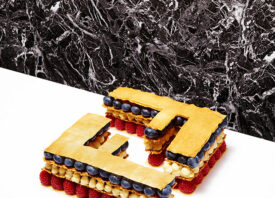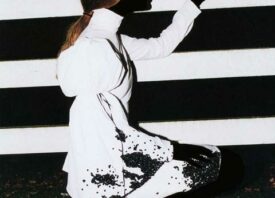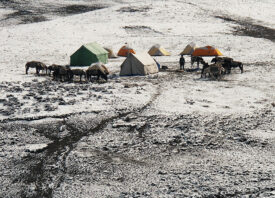Search this site
Captivating Photographs of Trauma Survivors Reenacting Scenes from a Missoni Catalogue
For her photography and video project Tractatus 7, the photographer Denise Prince replicates a catalog by high-end fashion house Missoni, replacing heavily retouched models with people
who have survived physical trauma. In the process, she breaks through the allure of fantasy, inviting us to peer beneath the glamour of fashion and into our shared reality.
What inspired you to pursue this project?
“I was in Lacanian psychoanalysis which, for me, included experiencing moments (or glimpses?) in between what I believed to be true; about myself, about life. Very much outside of experience that language could be used to account for. At times it seemed that the fantasies of who I believe I am fell to my feet. At other times I’d find myself in moments not just beyond my self but seemingly beyond all meaning, where nothing was real and there was both potential and nothingness. If it sounds displeasing, it wasn’t. There was a kind of captivating if uncanny grace.
“In analysis I also found contents from my unconscious coming into consciousness. There were a few particular early life experiences that had taken place out in the open in front of my extended family that had seemed potent (and somewhat traumatic) but were not spoken of. Later in life, this made me particularly sensitive to subtext. For example, as I transitioned into being an adult some of what is presented in advertisements that is meant to be taken for granted or ignored stood out to me. When an advertisement used sex overtly, I disliked the idea that this was there in front of everyone but that everyone pretended it wasn’t being said. I saw it and was compelled to say what I saw (in place of speaking up for what we’d all seen before and not spoken about).
“Often in analysis my impressions or fantasies about life and who I was also began to become more flexible. So, I was on a long drive and the idea of replicating a Missoni catalog with people who had experienced severe physical trauma came to me. I’d come across and kept a high end catalog from the fashion house Missoni because the heavy retouching on the models had fascinated me (they looked like mannequins and the iconic zig zag patterning was so colorful that season. The catalog was also entirely photographed on a beach that was clearly really just sand and props in a studio.)
“When I say the idea came to me I mean that the visuals began running through my mind. I simply pictured in place of the models in the catalog (fantasmatic, overly perfect, beyond the reach of reality) people who had had an experience that could not be denied or retouched or ignored. I didn’t trace the ideas to experiences in the formation of my subjectivity and at this point I see the significance of the work as unrelated to my experience. But this is what was happening when I began the work.”

How did you meet your models?
“I began looking for subjects by way of survivors’ support groups [and] would informally ask members if they were interested in participating. I also knew of people within my social circles or just a step beyond that. The woman I photographed who had anorexia I approached at a store. The veteran I worked with Bobby became a comedian during recovery from his injuries who I heard interviewed on NPR. I get this question a lot and it reminds me of how I was afraid at first to approach people. I soon realized that once people had sufficiently healed from their injuries and emotionally once they had renegotiated who they believed they were, they were more than used to their new normal. In turn, it becomes all but invisible to me once I spend much time with them. And to the extent it remains compelling, I think it functions as beauty does. I want to look in the same way I am captivated by the odd perfection in a standardly ‘beautiful’ face. A writer, Ian Grey, who wrote an essay on the work, said this and it’s relevant: ‘Your work frees them to deny a beggar’s position on the dull parade of standard attractiveness. The ‘pretty’ person becomes wan when faced with their ecstatically chaotic beauty. Instead of being trapped, their free forms flow amongst the couture. Their power is based on an essential mystery and is therefore limitless.'”

When our notions of the self are interrupted by physical or emotional trauma, what role does a project like this play in the healing process?
“This is a fascinating question because this work was made from the standpoint that my subjects serve as examples of people who have earned, through their experience with acute vulnerability, a great capacity to face the human condition. The way that this project intersects with healing is in its sincere deference towards (all of) our shared humanity. My interest in the people I have worked with on this regards their faculty and grace. During recorded interviews, the experiences they related about the continuing challenges of facing the day (if they were mitigating the effects of, for example, PTSD or another physical or emotional challenge or simply felt tired or off) were the stories of any human deeply facing life on life’s terms.
“While I’m not presuming to measure their suffering against any others, I mean to locate it, in terms of this project, as example of confronting the real. In that light, this project is an example of how my subjects have taken responsibility for desire. Desire is the memory of the missing thing. Having learned to take responsibility for what one can control of life which includes, ultimately, a great flexibility with and accounting of oneself in order to show up for life with the full range of one’s humanity. I believe art (including literature, etc) is an arena in which we may speak about the nature of human experience at great depth. And I believe that we have a fundamental desire to be seen for all the measure of who we are. This project serves as a meeting point in which to consider the nature of life with the awareness that being healed is itself a fantasy of desire.”

In some ways, your images recall film stills in that your subjects are active, unlike the passively reclining Missoni models. Was this intentional?
“The series I’m exhibiting under the title Tractatus 7 is itself titled Replication and Breakdown of the Missoni Estate Line Catalog. Breakdown refers to the photographs taken after the replicated pose from the catalog. During this time, I photograph each model doing what they like on the set, and I let the technical elements such as lighting, focus and framing disintegrate. The studio or room we are in, the edges of the set are visible and some of the work is made when they are in motion or are ‘not ready.’
Catalogue replication images are heavily retouched so that they meet commercial standards, and only one catalog replication image will be shown as it is the only one that meets the standards of advertising in my opinion (achieves a heightened state). The majority of the work that I’ll show comes from the breakdown of the commercial standards.”

What drew you to the title Tractatus 7?
“In the time since my analysis, the work of my analyst Charles Merward (who is also a philosopher) and mine has overlapped. Through this parallel play in our practices, I began to appreciate the significance of the work I was doing in terms of philosophical ideas. It has inroads for disciplines from art history, psychology and other healing/ recovery practices, fashion and commercial photography, gender and ethnicity studies, as well as psychoanalysis and philosophy. But in terms of philosophy, it seemed to be actually doing something unique.
“Tractatus 7 refers to a proposition made by philosopher Ludwig Wittgenstein that roughly translated states, ‘Whereof one cannot speak, thereof one must be silent.’ For the way my work points to experiences of the real (things that cannot be accounted for – not only with words but that we cannot make sense of, such as my subjects’ traumatic experiences), which serve as an example of all of which human beings cannot account for in life. You might say it ultimately all goes back to the human condition – that we are conscious that we live and therefore aware of our mortality.
“Well, Charles told me that he thinks my work is a counter argument to Wittgenstein’s 7th theses. One way to see how it points to this is looking at the way fashion works (stimulating desire by representing the imaginary body instead of a body subject to the real) and what fashion cannot account for. Since I insist that an experience with the real is a measure of capacity in the face of the human condition and photograph people who show evidence of this sort of experience in the context of fashion, it makes the formal requirements of fashion (as a delivery vehicle for desire) explicit. We enjoy the pleasure of the imaginary body for its imaginary relief from the human condition.
“I’m not attempting to critique fashion photography or deny anyone the respite of fantasy. I’m simply using what is rigid in this context to point to its structure. To point to the way fantasy organizes our experience of everyday reality and tells us who we are. It’s very pleasing because it satisfies that long ago impulse to speak about what would not be spoken of. I’ve found a voice for my fundamental experiences with the real.”

Theorist Susan Sontag wrote that the photograph has in many ways become a substitute for reality, that we understand and connect to the world through images of it. In the midst of retouched commercial imagery, why is it important that we see photographs like these?
“We believe that we are afraid of looking directly at what cannot be spoken of. We also scarcely realize that what we take for reality are shadows on a cave wall (a la Plato’s allegory). This is why it is important.”
What has the response to the work been like?
“During an open studio, people from all walks of life really responded to the work from a variety of points of entry. The curator of photography at the Museum of Fine Arts Houston who purchased a print for the collection said, ‘No one is making work like this… And that’s a good thing.’ The project is funded in part by the City of Austin Cultural Arts Division as well as private donors including master photographer Joel-Peter Witkin, who has been very supportive. The video that will be on view in the exhibition made New York art critic Jerry Saltz weep and thank me. There has been plenty of ambivalence also, of course. The work is best seen in photographic print format. There’s nothing like seeing a 40” x 40” print before you. When one sees the entire series it also changes the dynamic considerably. A language begins to develop. This is why I’ll show a slideshow of every frame I have taken. There is a great amount of complexity in what the body of work points to.”

What do you hope your models feel when they look at these images? Have you stayed in touch with any of them?
“I hope that the people I’ve worked with for this project have an experience like anyone else upon seeing the exhibition (adding a dash of pride for having been personally involved). Person A is temporarily taken back by the overall vision and unsure what to think (curious, bemused, stimulated). At this point a hearty, uncontrollable laugh would be completely appropriate, unexpected joy at the absurdity of it all, at which they throw their arms around someone nearby.
“Upon seeing the video, they would register the air of triumph or grandeur, the photographs would prove an encounter with a myriad of feelings; we would talk at length about their impressions and thoughts. Overall, it would prove an experience of having stepped down the rabbit hole or of having just seen a film that took them from tears to elation and find that they are now rested and ready to step back out the door into their life. Weeks later, person A notices the show has stuck with them. They think about it off and on and feel the a subtle way one feels when considering whether if not having not met a particular friend if their life would not have been quite as rich.
“Yes, I stay in touch with all of them, and most have told me they’re really into what I’ve done. They’re my people and I consider them forerunners of self-determination.”

Tractatus 7 opens Saturday, September 6 and will be open to the public from Sunday, September 7 until Saturday, September 27 at University Park in Austin, Texas.





